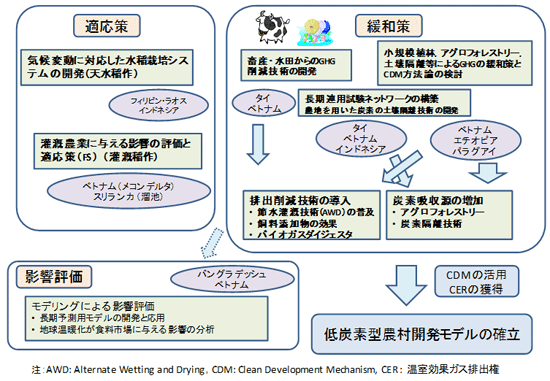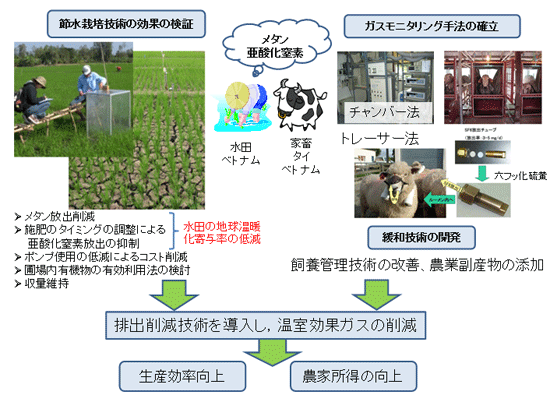Development of agricultural technologies in developing countries to respond to climate change
Related Research Program
Environment and Natural Resource Management
2021-03-02
気候変動対応プロジェクトは、節水灌漑の普及と飼養管理の改善によるGHG削減技術の導入、CDMの活用による低炭素型農村開発モデルの確立を目標にした緩和策に関する課題、天水稲作・灌漑稲作の適応策に関する課題、さらにコメの需給モデルを骨格に用いた影響評価に関する課題から構成されています(図1)。
緩和策については、水田においてGHG削減の有効性が確認されている節水栽培AWDの効果をメコンデルタで実証し普及を目指すものです。AWDとはAlternate wetting and dryingの略で、ある時期水田を乾燥させ、土壌を好気的にすることでメタン発生量を低減させるもので、農家とすれば灌漑のためのポンプ使用の低減等、コスト削減につながります(図2左)。
畜産分野については、反芻家畜から発生するメタンガスのモニタリング手法の確立と飼養管理技術の改善によるメタンガス発生抑制技術の開発を行います(図2右)。
低炭素型農村社会の構築に関する課題は、ベトナム、エチオピア、パラグアイで実施します。パラグアイ・エチオピアでは、荒廃地への植林とアグロフォレストリーの実施による炭素隔離を、ベトナムでは豚の糞尿からバイオガスを産生する装置を設置し、それにより化石燃料の利用を低減するCDMプロジェクトを国連CDM理事会に登録し,温室効果ガス排出権の獲得を目指します。
タイ、ベトナム、インドネシアでの有機物の長期連用試験ネットワークの構築では、有機物の長期連用が土壌炭素蓄積に与える影響を観測します。土壌中の有機物を増やすことは農家への総合的なメリットが大きく、堆肥、最小耕起栽培、緑肥作物の利用の有効性が示されます。
適応策については、国際稲研究所(IRRI)と海洋研究開発機構(JAMSTEC)との共同研究による天水稲作栽培技術に関わる課題と、ベトナム・スリランカにおける潅漑農業における適応策に関するFS課題があります。天水稲作栽培技術に関わる課題ではJAMSTECが開発した大気海洋結合モデルを活用した季節予報モデルと意志決定システムを開発し、天水稲作ではほとんど利用されてこなかった施肥の効果的な利用法を提案します。また、温暖化で問題となっている高温・低水分環境に適した品種の開発を、特に高温耐性を主眼においた育種を行います。
気候変動が農業に与える影響のモデルによる評価では、米を対象として、土壌や気象に関する栽培適地条件の変化を明らかにし、気候変動に伴う適地変化を予測する土地評価モデルを開発します。その情報と、耕地面積や収量等の作物生産要因のモデル、ならびに社会経済的要因モデルを合体させることで、気候変動予測に対応した国別需給モデルを開発します。そして、既存の世界食料モデルをアップデートしつつ、作物モデルも組み合わせて、長期予測が可能な世界食料モデルを開発します。
関連リンク
地球温暖化と農林水産業
JIRCASは、農水委託プロ気候変動対策A-7系の代表機関として、他系で開発される温暖化緩和・適応技術の経済評価を筑波大、農工研と共に、世界食料モデルなどを用いて行う予定です。
インドネシア・西ジャワ高原野菜生産における馬糞堆肥施用による化学肥料削減技術に関する現地語リーフレット
火山灰土壌地域に位置するインドネシアの西ジャワ州高原地帯は同国の温帯野菜の代表的な生産地です。同地域で馬糞を原料とする堆肥を施用し、作物収量に影響を与えることなく化学肥料施用を節減する技術を紹介する現地語(インドネシア語)リーフレットです。
- リーフレット
- 20200910.pdf866.53 KB


